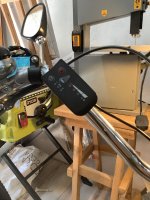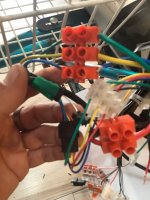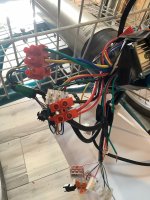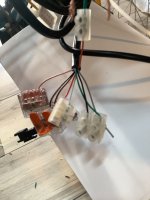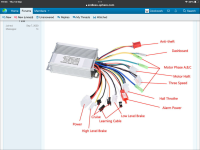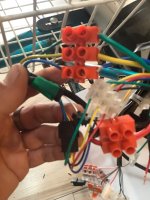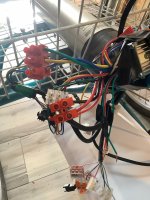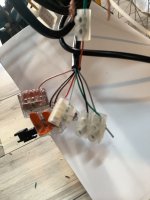I have a Yaegoo 36-48V 350W controller (wiring photo attached), that I want to solder to a 9-pin HiGo Z910 cable, which will plug into to my Bafang 350W front hub motor.
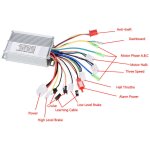
* The controller has three power wires: fat black, fat red, and thin red. What should I do with the thin red wire?
* The controller has five thin wires that terminate in a block that is labeled (with a glued-on paper label, in Chinese): "motor hall", red 5V, black ground, yellow/green/blue hall. The wiring photo shows this as "Hall Throthe" (in English)-- I think the English wiring photo is wrong, and the Chinese label is correct, and I should wire it according to the Chinese label. Do you agree? Can I use a multimeter to verify which wires connect to hall sensors?
* The controller has three thin wires that terminate in a block that is labeled: "three-wire switch", red 5V, black ground, green "signal line", although the wiring photo shows this as "Motor Hallt". I think this is for the twist-grip throttle connection-- do you agree?
* There's another block labeled as: "three gears variable speed", "blue: high speed signal", black: ground wire", "color code: low speed signal". What's it for?
* What are the two "cruise" wires for? Does this controller have cruise control? It would be great if it does, because rather than a throttle, I'd prefer a fixed speed 25km/h or fixed power of 150W.
* Can I ignore the two "anti-theft" wires, or do I need to wire them together (as if the ebike had a key that would connect these wires when it's turned "on")?
* Can I ignore the controller's other wires (dashboard, alarm power, low level brake, high level brake)? Are any of these good for 12V lights? (The ebike's battery is 36V.)
* The HiGo cable has a white "thermistor or motor speed sensor" wire. Ignore it?

* The controller has three power wires: fat black, fat red, and thin red. What should I do with the thin red wire?
* The controller has five thin wires that terminate in a block that is labeled (with a glued-on paper label, in Chinese): "motor hall", red 5V, black ground, yellow/green/blue hall. The wiring photo shows this as "Hall Throthe" (in English)-- I think the English wiring photo is wrong, and the Chinese label is correct, and I should wire it according to the Chinese label. Do you agree? Can I use a multimeter to verify which wires connect to hall sensors?
* The controller has three thin wires that terminate in a block that is labeled: "three-wire switch", red 5V, black ground, green "signal line", although the wiring photo shows this as "Motor Hallt". I think this is for the twist-grip throttle connection-- do you agree?
* There's another block labeled as: "three gears variable speed", "blue: high speed signal", black: ground wire", "color code: low speed signal". What's it for?
* What are the two "cruise" wires for? Does this controller have cruise control? It would be great if it does, because rather than a throttle, I'd prefer a fixed speed 25km/h or fixed power of 150W.
* Can I ignore the two "anti-theft" wires, or do I need to wire them together (as if the ebike had a key that would connect these wires when it's turned "on")?
* Can I ignore the controller's other wires (dashboard, alarm power, low level brake, high level brake)? Are any of these good for 12V lights? (The ebike's battery is 36V.)
* The HiGo cable has a white "thermistor or motor speed sensor" wire. Ignore it?


